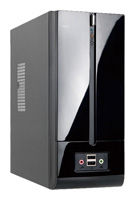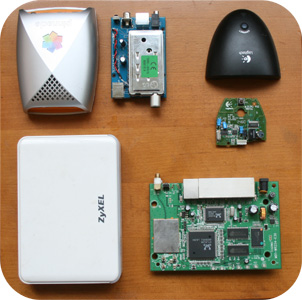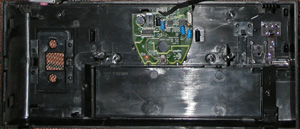
It all started with the fact that, being interested in the mini-ITX form factor, I put together a small home server. For a long time it was used as a file storage, then a little as a development server. Like any fan of computer technology, the number of all kinds of accessories grew at home - not necessary and necessary. The number of wires began to oppress. Imagine a mini-ITX case braided with wires like a cobweb. It is time to put an end to this.

Fig. 1
Fig. 2
Fig. 3
Fig. 4
Fig. 5




| The computer is a simple Intel GCLF motherboard, enclosed in the INWIN BM639 case. Having unscrewed the full-size CD drive, I found that there was enough space in the case for a wide range of devices. By the way, I used to worry that the case is simply huge and awkward, but if it weren’t like that, this article would not have taken place.
Two hard disks are installed in the case: 3.5 and 2.5 inches, placed in regular places, inside and outside the removable basket (lower right corner in Fig. 1).
Three devices were selected as the first candidates for implantation:
- Zyxel P-330W EE router (about it separately later)
- Radio module from an old but very comfortable Logitech mouse
- External TV tuner Pinnacle
The devices were removed from the standard cases. It is worth noting that all manipulations on additional equipment were carried out with the condition that they could be returned to their original state in terms of appearance and functionality.
The only thing I had to work on with a knife and file was the radio module for the mouse. I really wanted to somehow elegantly fix it in the case, for which we used standard (it’s not clear the truth for what purpose) latches inside the case cover. The processed board angle did not contain foil sections and was undoubtedly neatly removed (lower right corner of the upper right board in Fig. 2).
In the third picture, the used wires are presented, from left to right: the standard mouse radio module wire (not modified, but only intercepted by a hook), the wire from the USB cable to the rear panel (one of the connectors has been replaced with the necessary plug for the TV tuner), TV extension cable to output the antenna connector to the rear wall of the chassis and a network jumper to connect the network card of the motherboard to the socket on the router.
Now the main thing is the completion of the case. The result is shown in Figure 4. Armed with wire cutters, I bit out the extra jumpers in the grill on the back of the case. Under the number 1 will be the socket of the power supply of the router. At the moment it is not used, but access to it is provided for the case if it will be necessary to supply power only to the network component of the center and keep the computer turned off. In normal mode, power is supplied to the router from the computer’s power supply, - by a fortunate coincidence, Zyxel is powered by 12V. At the place indicated by the number 4, a toggle switch is installed to switch the power source (standard router power supply or computer power supply), which is also used to reboot the router.
The used router has one unpleasant feature: a wi-fi connection often hangs, and you have to periodically reset it. For two weeks I talked with the support of Zyxel, as a result of which they sent me a new firmware, on which the router does not hang yet. Which is a definite plus for me and for the reputation of the company.
At the place marked with the number 2, access to the network connectors of the router. Hole 3 on the case was already and is great for installing the antenna. Hole 5, made similar to hole 1, is used to fasten the plug of the TV antenna (I did not twist it for the duration of the shooting).
The mouse radio module, as I already said, is located in the front cover of the case (Fig. 5) and during assembly it is shifted by a small piece of foam for sealing and isolation. The TV tuner is still next to the hard drives and is held in this position by hard wires.
|
To fix the router, we use home-made wooden sleds installed in the basket of the CD drive, as well as the simplest clamping mechanism from a piece of the board.
After assembly, we have the appearance, as in Figure 6.

Fig. 6
As a result, they received a combine, as they say, from what it was. Ubuntu is installed on the media center, a web server, a file server, a torrent client are raised. I checked the work of the TV tuner and am currently dealing with streaming.
At home there is an extra (albeit the only) nineteen-inch LCD monitor, which is planned to be used as a "TV" in the bedroom or in the kitchen.
There are many more thoughts on how to continue what was started. From immediate plans: the output to the front panel of the TV tuner and IR sensor inputs to control the center from the remote, as well as replacing the motherboard and processor with more productive ones.
Photos separately (clickable):







 It all started with the fact that, being interested in the mini-ITX form factor, I put together a small home server. For a long time it was used as a file storage, then a little as a development server. Like any fan of computer technology, the number of all kinds of accessories grew at home - not necessary and necessary. The number of wires began to oppress. Imagine a mini-ITX case braided with wires like a cobweb. It is time to put an end to this.
It all started with the fact that, being interested in the mini-ITX form factor, I put together a small home server. For a long time it was used as a file storage, then a little as a development server. Like any fan of computer technology, the number of all kinds of accessories grew at home - not necessary and necessary. The number of wires began to oppress. Imagine a mini-ITX case braided with wires like a cobweb. It is time to put an end to this.












